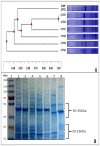Genomic investigation into strain heterogeneity and pathogenic potential of the emerging gastrointestinal pathogen Campylobacter ureolyticus
- PMID: 24023611
- PMCID: PMC3758288
- DOI: 10.1371/journal.pone.0071515
Genomic investigation into strain heterogeneity and pathogenic potential of the emerging gastrointestinal pathogen Campylobacter ureolyticus
Abstract
The recent detection and isolation of C. ureolyticus from patients with diarrhoeal illness and inflammatory bowel diseases warrants further investigation into its role as an emerging pathogen of the human gastrointestinal tract. Regarding the pathogenic mechanisms employed by this species we provide the first whole genome analysis of two C. ureolyticus isolates including the type strain. Comparative analysis, subtractive hybridisation and gene ontology searches against other Campylobacter species identifies the high degree of heterogenicity between C. ureolyticus isolates, in addition to the identification of 106 putative virulence associated factors, 52 of which are predicted to be secreted. Such factors encompass each of the known virulence tactics of pathogenic Campylobacter spp. including adhesion and colonisation (CadF, PEB1, IcmF and FlpA), invasion (ciaB and 16 virB-virD4 genes) and toxin production (S-layer RTX and ZOT). Herein, we provide the first virulence catalogue for C. ureolyticus, the components of which theoretically provide this emerging species with sufficient arsenal to establish pathology.
Conflict of interest statement
Figures




References
-
- Man SM (2011) The clinical importance of emerging Campylobacter species. Nat Rev Gastroenterol Hepatol 8: 669–685. - PubMed
-
- Moore JE, Corcoran D, Dooley JS, Fanning S, Lucey B, et al. (2005) Campylobacter. Vet Res 36: 351–382. - PubMed
-
- Bullman S, Lucey B, Sleator RD (2012) Molecular diagnostics: the changing culture of medical microbiology. Bioeng Bugs 3: 1–7. - PubMed
-
- Bullman S, Corcoran D, O'Leary J, Lucey B, Byrne D, et al. (2011) Campylobacter ureolyticus: an emerging gastrointestinal pathogen? FEMS Immunol Med Microbiol 61: 228–230. - PubMed
Publication types
MeSH terms
Substances
Associated data
- Actions
- Actions
- Actions
- Actions
- Actions
- Actions
- Actions
- Actions
- Actions
- Actions
- Actions
- Actions
- Actions
- Actions
- Actions
- Actions
- Actions
- Actions
- Actions
- Actions
- Actions
- Actions
- Actions
- Actions
- Actions
- Actions
- Actions
- Actions
- Actions
- Actions
- Actions
- Actions
- Actions
- Actions
- Actions
LinkOut - more resources
Full Text Sources
Other Literature Sources
Medical
Molecular Biology Databases
Miscellaneous

